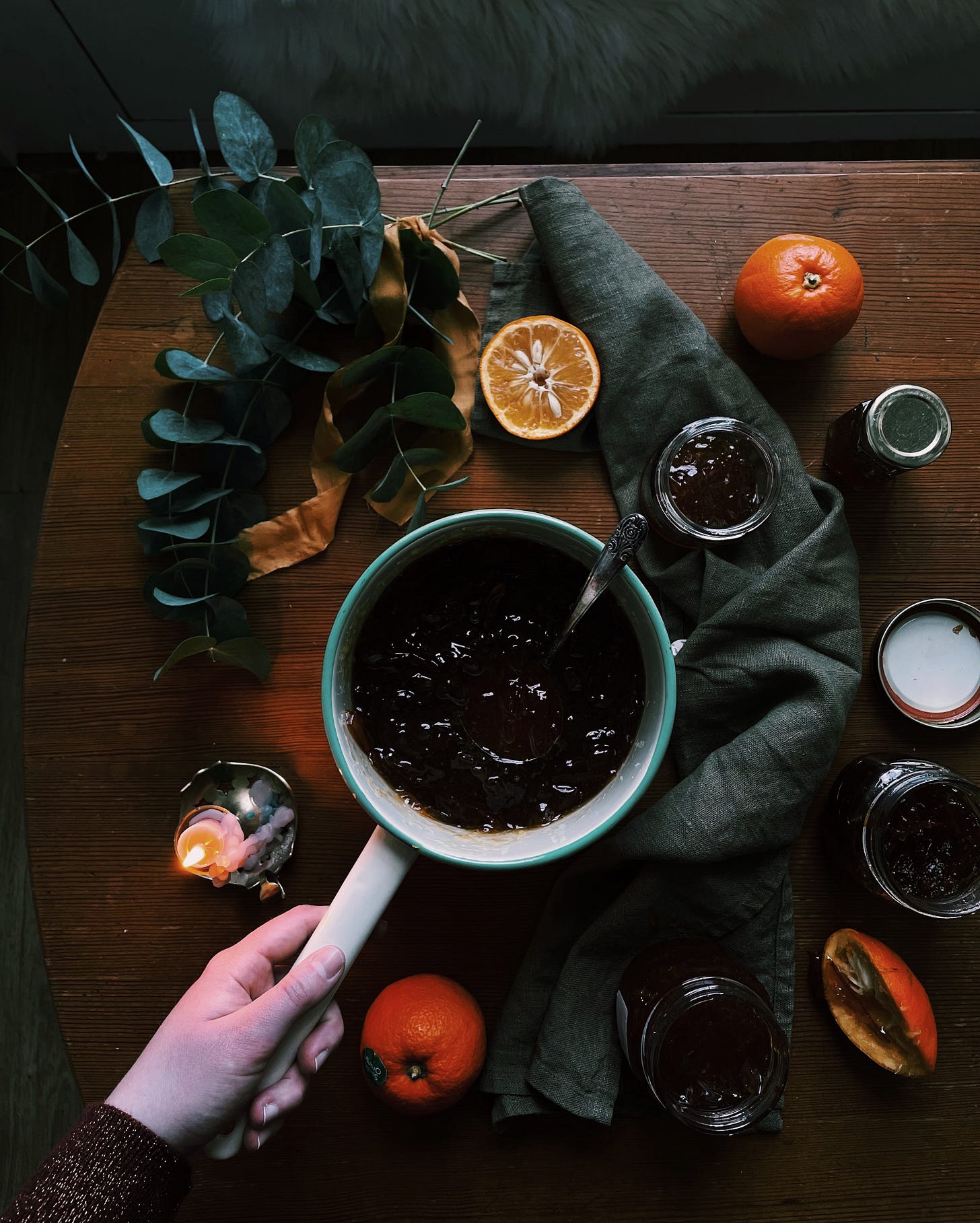Marmalade Memory Making
Making marmalade is an all-day event. With some recipes, it’s a whole weekend. This is not something to make in a hurry, and you’ll find no hacks or corner-cutting tips here. Surely, speed is the antithesis of what marmalade is all about. Preserving is something that refuses to be rushed and, for me, is infused deeply with nostalgia.
This is culinary mindfulness at its most sensory. Each step of the process is a feast of colour, scent, taste and texture. The intensely flavoured preserve distils the bittersweet flavour of orange like nothing else, and the process is pure alchemy. Seville orange season is impeccably timed to coincide with the coldest, darkest time of year, offering longed-for colour and flavour. While preserving is most often associated with the Summer, there’s just something so comforting about tending a simmering pot of amber marmalade on a crisp, cold day. It’s a Winter ritual: marmalade memory making.
Marmalade is particularly precious due to the short, sweet season of Seville oranges. The time-consuming nature of making proper marmalade means that the real-deal preserve made in small batches is luxury at its most authentic. Early marmalade was made by pounding the fruit in a mortar and pestle to make a thick paste similar to quince paste, though the origins of marmalade are confused at best. Several of these stories originate in Scotland. The preserve is linked with the Sutherland Clan whose seat, Dunrobin Castle, houses a notebook containing one of the first recorded recipes.
Contemporary marmalade as we would define it is attributed to the Keiller family, who apparently bought a load of discounted oranges from a cargo ship stuck in Dundee after a storm, and invented marmalade. They went on to found the first marmalade factory in 1797 and popularised the preserve. The first ever published Scottish cookery book, ‘A New and Easy Method of Cookery’, makes reference to the ‘chipped’ style marmalade in 1752. Famous anti-Scot Samuel Johnston was even a convert to the breakfast preserve.
I was never a huge marmalade fan until I made my own. That sounds like I’m tooting my own horn, but the opportunity to customise the texture and set of the jam makes all the difference. Whether you like your marmalade with finely shredded peel or with thick chunks of fruit, softly set or thick enough to stick to your ribs, you can tweak the process to suit your own tastes. To the uninitiated, marmalade making seems daunting as there are three stages: softening the fruit, extracting the pectin and adding the sugar to make the preserve. But with practise and patience you too can have your own annual ritual making marmalade memories.
Most recipes use a 1:2 ratio of fruit to sugar. Trust me – this lip-puckering fruit needs it. You can experiment with different types of sugar; I love the caramel note that demerara gives the marmalade.
Marmalade:
1 kg Seville oranges
2kg demerara sugar
2.5 litres of water
Equipment:
Large, heavy bottomed pan or preserving pan
Sieve
Muslin
String
Preserving jars.
1) First, wash the oranges and scrub them so they’re perfectly clean. Cut the oranges in half and squeeze them into the pan using a sieve to catch any pips, pith and flesh. Transfer this to the muslin and make into a bag, tied tightly with string.
2) Cut the peel into strips – the size depends on your preference. I like mine in nice thin shreds. Regardless of size, make sure it’s consistent so the peel cooks evenly.
3) Put the shredded peel into the pan and add 2.5 litres of water and the muslin bag. Bring to the boil and simmer for 2 hours, or until the peel is cooked through.
4) Remove the muslin bag and set aside to cool completely. Wash your jars in warm soapy water, then transfer to a low oven to dry. This will sterilise them. Boil the lids in a pan of boiling water and set aside. Put some saucers in the fridge to cool down ready to test your set.
5) Once cooled, squeeze the muslin bag into the marmalade mixture. Return to the heat and bring to a simmer, adding the sugar then stirring it until it is completely dissolved.
6) Raise the heat and boil rapidly until the jam reaches setting point – 104C. It’s worth using a sugar thermometer to keep you on track, but I always check the set by placing a teaspoon of marmalade onto a cold saucer and putting it in the fridge for a minute or two, then applying the wrinkle test: if you put your finger through it and a clear line is left behind, it’s ready. If not, keep boiling and check every few minutes.
7) Allow to sit for 20 minutes or so (this lets the peel settle). At this stage you can add extra flavours. Personal favourites of mine include cardamom or vanilla to balance the bitterness of the preserve. Stir in, then decant into your prepared jars.
What to do with your Marmalade:
The most obvious pairing is toast of course - I love mine with tangy white sourdough.
A marmalade steamed pudding is a great way of using lots of marmalade and adding deep flavour to a steamed pud. Serve with whisky custard.
Use it in a marinade for tofu or chicken.
Mix a couple of spoonfuls into your go-to sponge batter for an orange flavour hit.
Happy marmalade making!
p.s. I’ll be going live on Instagram this Sunday for my Monthly Makes: this month - by popular request - is beeswax candle making. Follow me there for more details.




I love this, Rosie! In my serial novel, there’s quite a lot of talk around marmalade and its origins (characters speculating on its history) and now you’ve answered “their” questions!